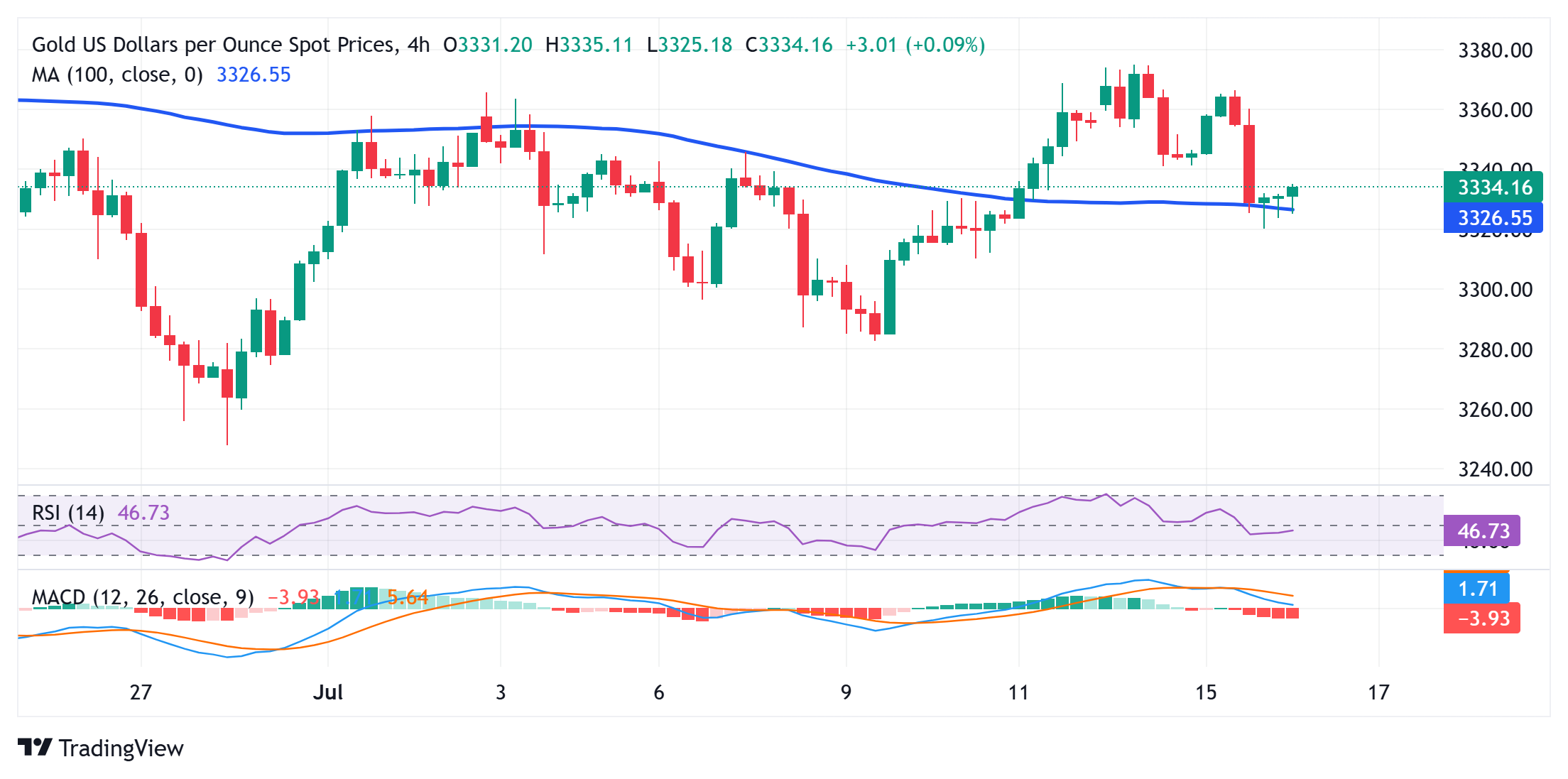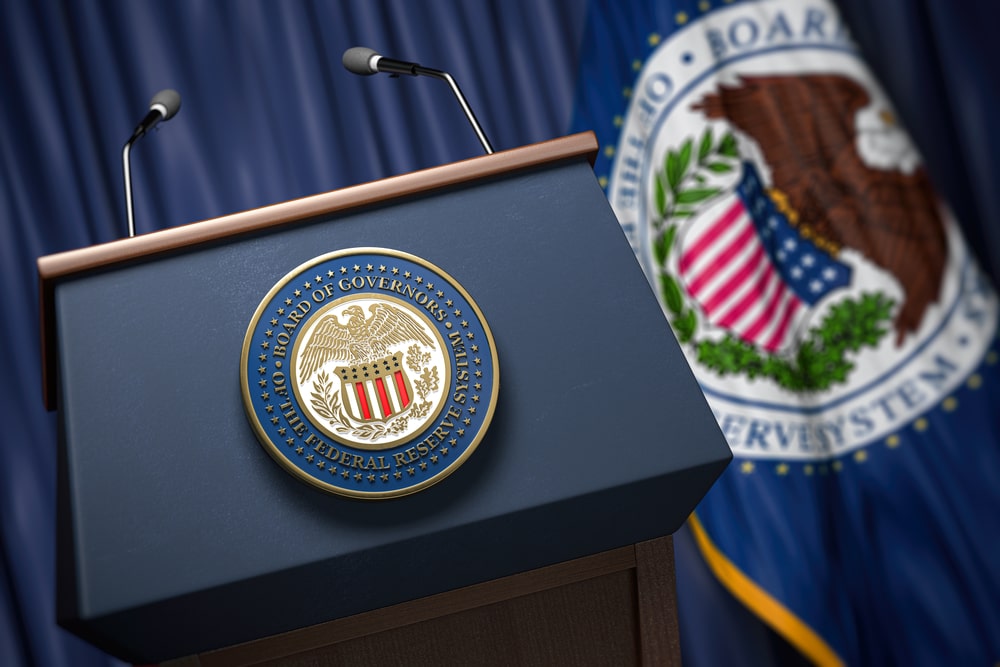Gold price advances to $3,335 area; lacks bullish conviction amid reduced Fed rate cut bets

- Gold price attracts dip-buyers following a weaker close for the second day on Tuesday.
- Persistent trade-related uncertainties and a softer risk tone benefit the safe-haven commodity.
- Reduced Fed rate cut bets acted as a tailwind for the USD and capped the non-yielding yellow metal.
Gold price (XAU/USD) edges higher during the Asian session on Wednesday and reverses a part of the overnight downfall to a multi-day low, though it lacks follow-through buying. Against the backdrop of persistent uncertainties over US President Donald Trump’s trade tariffs, bets that the Federal Reserve (Fed) will keep interest rates elevated temper investors' appetite for riskier assets. This is evident from a weaker tone around the equity markets and turns out to be a key factor lending some support to the safe-haven precious metal.
Meanwhile, the US Dollar (USD) pauses for a breather following Tuesday's blowout rally to its highest level since June 23 and further benefits the Gold price. However, expectations that the Fed would delay cutting interest rates, amid a slight pickup in US inflation, act as a tailwind for the USD and might hold back traders from placing aggressive bullish bets around the non-yielding yellow metal. This warrants caution before positioning for any further appreciating move as traders now look to the US Producer Price Index (PPI) for a fresh impetus.
Daily Digest Market Movers: Gold price attracts safe-haven flows amid trade concerns
- The US Bureau of Labor Statistics reported on Tuesday that the headline Consumer Price Index (CPI) increased the most in five months, by 0.3% in June, and the yearly rate accelerated to 2.7% from 2.4% in May. Meanwhile, the core gauge, which excludes fluctuating food and energy costs, rose 2.9% YoY from 2.8% in the previous month.
- The data sparked concerns over the inflationary effects of US President Donald Trump's trade tariffs and reaffirmed bets that the Federal Reserve will keep rates higher for an extended period. This lifted the US Treasury bond yields higher and the US Dollar to its highest level since June 23, dragging the Gold price to a multi-day trough.
- Boston Fed President Susan Collins noted that it is challenging to set monetary policy right now amid uncertainty, and a solid economy gives the US central bank time to decide its next interest rate move. Tariffs could boost inflation over the second half of 2025 and push core inflation to around 3% by year's end, Boston added further.
- Separately, Dallas Fed President Lorie Logan said the base case is that monetary policy needs to hold tight for a while longer to bring inflation down. Logan added that tariff increases appear likely to create additional inflationary pressure for some time, and an early rate cut by the Fed risks deeper economic scars on a longer road to price stability.
- Meanwhile, Trump said on Tuesday that 200% tariffs on pharmaceutical imports will come by the month-end. This comes on top of Trump's tariff notices to more than 20 countries and a 50% tariff on copper imports last week, which keeps investors on edge and assists the safe-haven precious metal to attract some dip-buying on Wednesday.
- Traders now look forward to the release of the US Producer Price Index due later during the North American session. Apart from this, comments from influential FOMC members will drive the USD and provide a fresh impetus to the XAU/USD pair. The mixed fundamental backdrop, meanwhile, warrants caution for aggressive traders.
Gold price bounces off pivotal throwback near 100-SMA on H4

From a technical perspective, the commodity shows some resilience below the 100-period Simple Moving Average (SMA) on the 4-hour chart and, for now, seems to have stalled the retracement slide from a three-week top touched on Monday. That said, oscillators on the said chart are yet to confirm bullish bias and warrant some caution before positioning for further gains. Hence, any subsequent move up might confront an immediate hurdle near the $3,342-3,343 region, above which the Gold price could retest the $3,365-3,366 horizontal barrier. Some follow-through buying, however, would set the stage for a move towards reclaiming the $3,400 round figure.
On the flip side, weakness below the $3,320 area, or the weekly trough touched on Tuesday, is more likely to find decent support near the $3,300 round figure. This is followed by the $3,283-3,282 region, or over a one-week low touched last Tuesday, which, if broken, would make the Gold price vulnerable to accelerate the corrective fall towards the July swing low, around the $3,248-3,247 zone.
Fed FAQs
Monetary policy in the US is shaped by the Federal Reserve (Fed). The Fed has two mandates: to achieve price stability and foster full employment. Its primary tool to achieve these goals is by adjusting interest rates. When prices are rising too quickly and inflation is above the Fed’s 2% target, it raises interest rates, increasing borrowing costs throughout the economy. This results in a stronger US Dollar (USD) as it makes the US a more attractive place for international investors to park their money. When inflation falls below 2% or the Unemployment Rate is too high, the Fed may lower interest rates to encourage borrowing, which weighs on the Greenback.
The Federal Reserve (Fed) holds eight policy meetings a year, where the Federal Open Market Committee (FOMC) assesses economic conditions and makes monetary policy decisions. The FOMC is attended by twelve Fed officials – the seven members of the Board of Governors, the president of the Federal Reserve Bank of New York, and four of the remaining eleven regional Reserve Bank presidents, who serve one-year terms on a rotating basis.
In extreme situations, the Federal Reserve may resort to a policy named Quantitative Easing (QE). QE is the process by which the Fed substantially increases the flow of credit in a stuck financial system. It is a non-standard policy measure used during crises or when inflation is extremely low. It was the Fed’s weapon of choice during the Great Financial Crisis in 2008. It involves the Fed printing more Dollars and using them to buy high grade bonds from financial institutions. QE usually weakens the US Dollar.
Quantitative tightening (QT) is the reverse process of QE, whereby the Federal Reserve stops buying bonds from financial institutions and does not reinvest the principal from the bonds it holds maturing, to purchase new bonds. It is usually positive for the value of the US Dollar.








